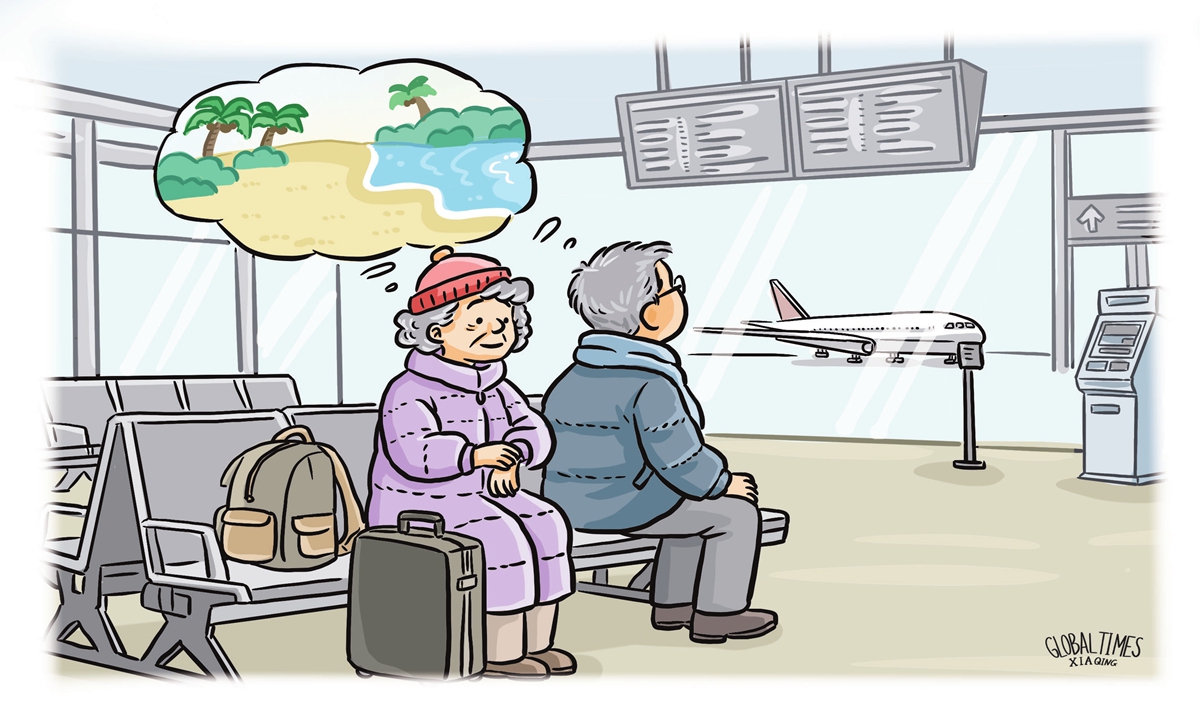Trend of ‘migratory bird’ lifestyle highlights retirees’ rising role in China’s consumption

Illustration: Xia Qing/GT
As temperatures drop across northern China, many seniors are once again embarking on their annual "migratory bird" journey southward. According to CCTV News on Sunday, the travel peak for these "migratory seniors" began in mid-September and will continue through mid-November, with large numbers of elderly travelers flying daily to southern destinations to enjoy life in warmer climates. On a flight from Changchun in Northeast China's Jilin Province to Sanya in South China's Hainan Province on Friday, passengers above 70 years old accounted for nearly one-third of the total, according to the report.
This increasingly mature "migratory seniors" market exemplifies China's consumption upgrade and the expansion of its silver economy. The trend connects multiple sectors - from healthcare and cultural tourism to elder-friendly technology. Rather than a short-term trend, it is evolving into an increasingly important driver for regional coordination and high-quality economic growth.
The "migratory bird" lifestyle of China's retirees reflects a shift in their spending habits. Retirement, once largely confined to home and community, has evolved into an experience- and quality-driven pursuit. Seniors are increasingly willing to pay for pleasant climates, convenient healthcare, and efficient transportation, boosting demand for aviation, railways, hotels, healthcare, and catering - opening a unique window for domestic consumption growth.
The rise of the "migratory seniors" market is fostering economic interaction and balance between China's northern and southern regions. Southern destinations such as South China's Hainan Province, Guangxi Zhuang Autonomous Region and Southwest China's Yunnan Province have developed eldercare-oriented travel communities, attracting a stable influx of senior residents with strong spending power.
Meanwhile, northern cities are exploring summer retreat models to attract elderly migrants escaping the southern heat, building toward a two-way migration pattern across regions. This seasonal population flow represents a redistribution of resources, services, and industries - an emerging form of coordinated development.
Equally significant, the trend is accelerating the modernization of China's old age-friendly public service systems. Cross-regional integration in healthcare and community services has become increasingly needed. Moves such as the interconnection of medical insurance settlements could further enhance migratory seniors' quality of life while unleashing the sustainable potential of the silver economy.
Still, the rapid growth of migratory retirees is not without challenges. Some destination cities struggle to align public service resources with surges in seasonal population. In addition, the influx of elderly residents has driven up local rental prices. Irregular business practices have also emerged as market players rush to capture this growing demand, calling for stronger regulatory oversight.
In response, systems for cross-regional medical reimbursement and pension insurance are being refined to better support mobile elderly populations. Regulators are stepping up supervision to ensure transparent, standardized operations. As the supply side improves - with higher-quality, safer, and more affordable products - more seniors are finding a balance between comfort and cost in their "migratory bird" lifestyles.
The trend of "migratory bird" lifestyle of Chinese seniors is poised to move toward a more structured and sustainable development model. Enterprises are expected to find major growth opportunities in emerging hybrid sectors such as "healthcare plus tourism." Together, these innovations could form a more inclusive silver economy ecosystem - one that treats elderly consumers as a crucial source of economic vitality.
China's silver economy has already reached an impressive scale, with immense potential. According to recent research from the Economic Forecasting Department of the State Information Center, the market of China's silver economy was estimated at 8.3 trillion yuan ($1.17 trillion) in 2024 and is projected to exceed 20 trillion yuan by 2030.
From a broader perspective, "migratory bird" lifestyle is a microcosm of China's economic transition in the context of population aging. It highlights the growing role of the elderly as a driving force in domestic consumption. Turning the seasonal "silver dividend" into lasting structural momentum will be a key growth theme in China's path toward high-quality development.
Photos
Related Stories
- China rolls out measures to boost inbound consumption
- Pocket-size bag charms sway into style in China
- Singles Day off to big buying bang
- Leading luxury goods group sees signs of recovery in China
- News Analysis: Understanding China's new consumption reality
- China's efficient cold-chain logistics drive consumption growth
Copyright © 2025 People's Daily Online. All Rights Reserved.









